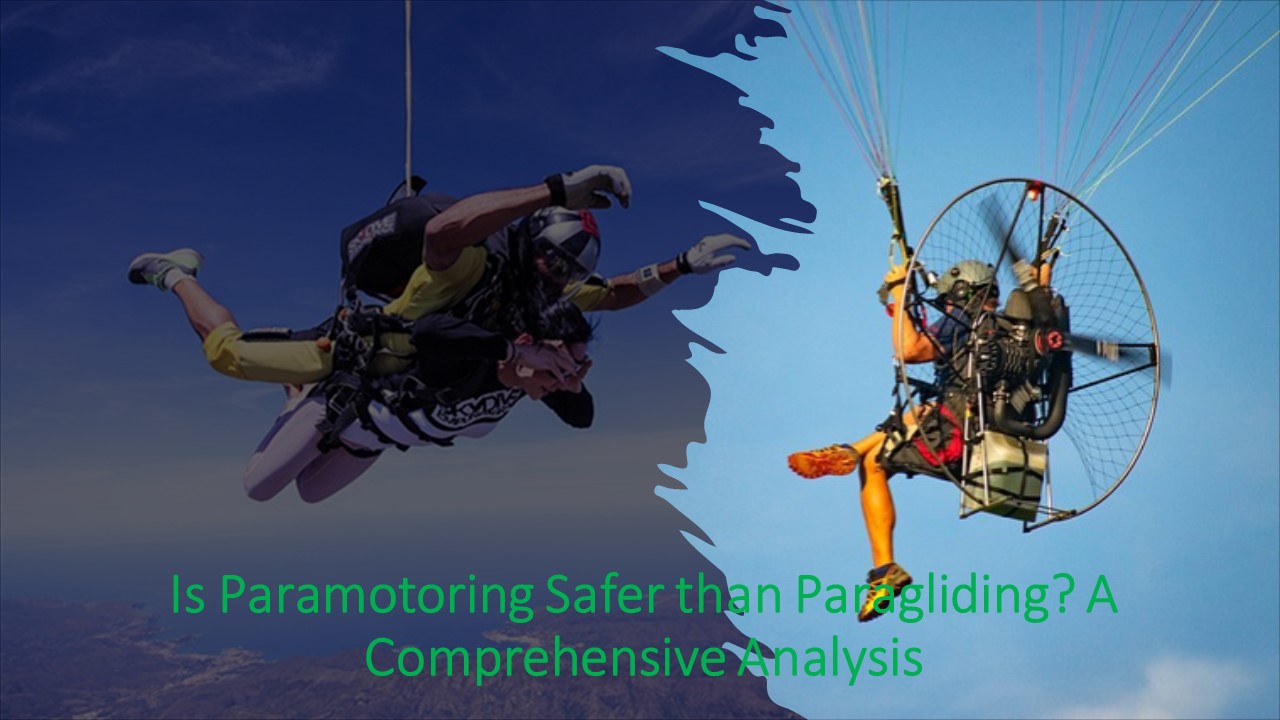In recent years, airborne adventure sports such as paramotoring and paragliding have captured the imagination of thrill-seekers worldwide. These exciting activities offer a unique blend of adrenaline-pumping excitement and serene natural beauty as participants soar through the skies. However, as with any adventurous pursuit, safety is paramount, and potential enthusiasts often wonder if is paramotoring safer than paragliding.
While some studies suggest that paramotoring has a slightly lower accident rate, safety in both paramotoring and paragliding largely depends on proper training, equipment maintenance, and responsible decision-making. It is essential for pilots to prioritize these factors to ensure a safe flying experience in either sport.
However, in this guide, I will delve into the world of paramotoring and paragliding, providing a comprehensive analysis of the safety aspects of each sport. My goal is to help you make an informed decision about which airborne adventure sport is right for you while prioritizing safety at all times. I will cover the basics of each sport, compare their safety factors, examine accident statistics, and offer practical tips for ensuring a safe and enjoyable experience.
So, let’s take flight and explore the captivating realm of paramotoring and paragliding!
What is Paramotoring?
Paramotoring, also known as powered paragliding or PPG, is an exciting form of ultralight aviation that combines the freedom of paragliding with the added versatility of a small engine. This engine, known as a paramotor, is worn on the pilot’s back and provides thrust, allowing for powered takeoffs, extended flight times, and enhanced maneuverability.
- Definition and history of paramotoring: Paramotoring emerged in the late 1980s as an evolution of paragliding, offering pilots the ability to take off from flat ground without the need for a hill or mountain launch. It quickly gained popularity among aviation enthusiasts, as it provided a relatively affordable and accessible means of experiencing personal flight.
How paramotoring works:
- Equipment involved: A paramotor setup typically consists of three main components: the paramotor (engine and harness), the wing (paraglider), and a helmet with communication equipment. The paramotor provides the necessary thrust for takeoff and flight, while the paraglider wing offers lift and control. The pilot is secured in a harness, which is attached to the paramotor and the wing.
- Training and certification: While paramotoring is considered more accessible than some other forms of aviation, proper training is crucial for a safe experience. Prospective pilots should seek instruction from a certified paramotor school or instructor to learn essential skills such as launching, landing, and in-flight maneuvering. In some countries, a specific paramotor certification or license may be required, while in others, no formal certification is needed. Regardless, proper training remains vital for safety.
The popularity of paramotoring:
- Advantages: Paramotoring offers several advantages over traditional paragliding, such as the ability to launch from flat ground, increased flight duration, and better control over flight paths. Additionally, paramotors can be easily transported and set up, making them an attractive option for those looking for a portable and flexible flying experience.
- Common misconceptions: Despite its many benefits, paramotoring is sometimes misunderstood. Some may believe it to be noisy or environmentally unfriendly due to the presence of an engine. However, modern paramotors are relatively quiet and fuel-efficient, making them a more eco-conscious choice than one might initially assume.
What is Paragliding?
Paragliding is a thrilling recreational and competitive adventure sport involving free-flying through the air using a lightweight, foot-launched aircraft called a paraglider. The paraglider wing, a fabric structure with a series of interconnected cells, creates lift and allows pilots to soar, glide, and maneuver through the sky without the need for an engine.
- Definition and history of paragliding: The origins of paragliding can be traced back to the 1960s when Domina Jalbert, a French-Canadian engineer, invented the ram-air parachute. This invention laid the groundwork for the modern paraglider wing. In the 1980s, paragliding began to gain popularity as an independent sport, distinct from skydiving and hang gliding, and since then, it has continued to grow in popularity worldwide.
How paragliding works:
- Equipment involved: The primary components of paragliding equipment include the paraglider wing, a harness, a helmet, and a reserve parachute for emergency situations. The paraglider wing is made of specialized fabric, with interconnected cells that fill with air to create lift. The pilot is suspended beneath the wing in a comfortable harness, which also houses the reserve parachute.
- Training and certification: Like paramotoring, proper training is crucial for safely participating in paragliding. Prospective pilots should attend a reputable paragliding school or seek instruction from a certified instructor. Training typically involves learning essential skills such as launching, landing, and in-flight maneuvering. Additionally, pilots must develop a thorough understanding of weather conditions, airspace regulations, and site-specific considerations. Depending on the country, a paragliding certification or license may be required.
The popularity of paragliding:
- Advantages: Paragliding offers an unparalleled sense of freedom and a unique way to experience nature. It allows pilots to access remote locations, explore the skies, and even soar with birds. The sport also fosters a strong sense of community among participants, with pilots often gathering to share experiences, knowledge, and advice.
- Common misconceptions: One common misconception about paragliding is that it is an extremely dangerous sport. While there are inherent risks involved, proper training, equipment maintenance, and adherence to safety guidelines can significantly reduce these risks. Another misconception is that paragliding requires great physical strength; however, the sport primarily relies on technique, understanding of weather conditions, and sound decision-making.
Comparing Safety Factors in Paramotoring and Paragliding
When considering the safety of paramotoring and paragliding, it’s essential to compare various factors that can impact the risk level associated with each sport. By examining equipment, training, weather conditions, and pilot skill, You can gain a clearer understanding of their relative safety.
Equipment and gear:
- Quality and maintenance: Both paramotoring and paragliding require well-maintained and reliable equipment for safe operation. For both sports, it’s crucial to use high-quality gear from reputable manufacturers, performs regular inspections, and address any issues promptly. While paramotoring introduces the added complexity of an engine, proper maintenance can mitigate potential risks.
- Backup systems: Both paramotoring and paragliding pilots typically carry a reserve parachute as a backup safety measure in case of an emergency. This additional layer of safety can help to minimize the risk of serious injury during an incident.
Training and certification:
- Importance of proper training: Proper training is crucial for both paramotoring and paragliding, as it equips pilots with the skills and knowledge required to safely navigate various situations. Learning from certified instructors or attending reputable schools is vital to reducing risks associated with both sports.
- Comparison of training requirements for both sports: While the basic principles of flight are similar for paramotoring and paragliding, each sport has its unique nuances, making specialized training necessary. However, it’s generally accepted that paramotoring has a slightly shorter learning curve due to powered takeoffs and the ability to maintain altitude with the engine.
Weather conditions:
- Impact on safety: Weather conditions play a significant role in the safety of both paramotoring and paragliding. Pilots must develop a thorough understanding of how factors such as wind, thermals, and turbulence can impact their flights. In general, paramotoring allows for a wider range of flyable weather conditions, as the engine provides more control over altitude and direction. However, it’s crucial for pilots of both sports to recognize and respect their limitations in various weather conditions.
- Choosing optimal conditions for each sport: For paragliding, ideal conditions often involve light to moderate winds and stable thermals, which facilitate smooth, predictable flights. In contrast, paramotoring pilots may prefer calmer conditions with little to no wind for easier takeoffs and landings. In both cases, avoiding turbulent or rapidly changing weather conditions is essential for safety.
Pilot skill and experience:
- The learning curve for both sports: While paramotoring is generally considered to have a shorter learning curve, both sports require practice and dedication to achieve proficiency. As pilots gain experience, their ability to safely navigate various situations improves, reducing the risk of accidents.
- Role of experience in reducing risk: Experience plays a crucial role in enhancing safety for both paramotoring and paragliding pilots. As pilots accumulate flight hours and encounter different scenarios, they develop better decision-making skills and situational awareness, contributing to a safer overall flying experience.
In conclusion, while there are differences in the safety factors associated with paramotoring and paragliding, it’s crucial to remember that individual skill, proper training, and adherence to safety guidelines are the most significant determinants of risk in either sport.
Accident Statistics and Safety Records
A thorough analysis of accident statistics and safety records can provide valuable insight into the relative safety of paramotoring and paragliding. By examining common causes of accidents and comparing the safety records of both sports, we can better understand their inherent risks.
Paramotoring accident statistics:
- Common causes of accidents: The most common causes of paramotoring accidents include pilot error, equipment failure, and unfavorable weather conditions. Pilot error may involve poor decision-making, inadequate pre-flight preparation, or misjudgment of weather conditions. Equipment failure can result from improper maintenance, manufacturing defects, or wear and tear. Lastly, rapidly changing or severe weather conditions can contribute to accidents if pilots are unable to react appropriately.
- Preventive measures: To reduce the risk of paramotoring accidents, pilots should receive proper training, maintain their equipment diligently, and consistently monitor weather conditions. Additionally, pilots should always respect their personal limits and skill levels, avoiding situations they’re not prepared for.
Paragliding accident statistics:
- Common causes of accidents: Similar to paramotoring, the most common causes of paragliding accidents include pilot error, equipment failure, and unfavorable weather conditions. In paragliding, pilot error may involve misjudging launch or landing conditions, improper control input, or flying beyond personal limits. Equipment failure can be related to poor maintenance, manufacturing defects, or wear and tear. Weather conditions, especially turbulence, and strong winds can also contribute to accidents.
- Preventive measures: As with paramotoring, reducing the risk of paragliding accidents involves proper training, regular equipment maintenance, and staying informed about weather conditions. Pilots should also maintain situational awareness, continually assess their surroundings, and avoid flying in conditions beyond their skill level.
Comparison of safety records for both sports:
- Which sport has a better safety record? While it is challenging to make a definitive statement regarding the overall safety of paramotoring versus paragliding, some studies suggest that paramotoring has a slightly lower accident rate. However, this data may vary depending on factors such as regional differences, reporting methods, and the number of participants in each sport.
- Factors contributing to the difference in safety: The difference in safety records between paramotoring and paragliding may be attributed to various factors, such as pilot experience, equipment maintenance, and weather conditions. For instance, the engine in paramotoring provides additional control, allowing pilots to avoid some situations that might be hazardous for paragliders. However, it’s essential to remember that individual factors, such as proper training and decision-making, play a significant role in ensuring safety in either sport.
In summary, while there may be differences in accident statistics and safety records for paramotoring and paragliding, it’s crucial for pilots to prioritize proper training, equipment maintenance, and sound decision-making to minimize risk and ensure a safe flying experience.
Tips for Ensuring a Safe Experience in Both Sports
Regardless of whether you choose paramotoring or paragliding, safety should always be a top priority. By following these tips, you can minimize risks and enjoy a safer experience in either sport.
- Choosing a reputable school or instructor: Investing in proper training from a certified and reputable school or instructor is crucial for acquiring the necessary skills and knowledge to fly safely. Ensure that your chosen training provider has a track record of success and adheres to the safety standards established by national or international paragliding or paramotoring organizations.
- Proper maintenance of equipment: Regularly inspect and maintain your equipment to ensure its reliability and safety. This includes checking for wear and tear, addressing any issues promptly, and following the manufacturer’s guidelines for maintenance and replacement. Remember that well-maintained gear is crucial for a safe flying experience.
- Continuously improving skills and knowledge: Even after completing initial training, continue to refine your skills and expand your knowledge. Attend advanced courses, participate in skill-building workshops, and learn from experienced pilots to enhance your understanding of both sports. Staying up-to-date on best practices and safety guidelines is essential for maintaining a high level of safety.
- Assessing and respecting personal limits: Be honest with yourself about your skill level and capabilities. Avoid flying in conditions or situations that exceed your current abilities, and recognize that it’s okay to cancel a flight if you’re feeling uncomfortable or unprepared. Pushing your limits can lead to accidents, so it’s essential to respect your personal boundaries.
- Adhering to safety guidelines and recommendations: Follow the safety guidelines and recommendations provided by your training school, national or international organizations, and experienced pilots. These guidelines are designed to minimize risk and ensure a safer flying experience. Be familiar with the airspace regulations and site-specific rules in the areas where you plan to fly.
Conclusion
Paramotoring and paragliding are both exhilarating airborne adventure sports that offer unique experiences and breathtaking views of the world from above. While they share similarities in flight principles and equipment, each sport has its distinct characteristics, advantages, and challenges.
When it comes to safety, a direct comparison between paramotoring and paragliding is not straightforward, as both sports have their inherent risks and factors that can influence accident rates. However, the most critical aspect of ensuring safety in either sport lies in proper training, equipment maintenance, and responsible decision-making.
Ultimately, the choice between paramotoring and paragliding depends on your personal preferences, goals, and abilities. By prioritizing safety and following the tips outlined in this guide, you can minimize risks and enjoy a thrilling and unforgettable experience in the skies. So, strap on your harness, spread your wings, and embark on the adventure of a lifetime!










